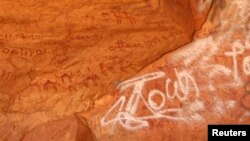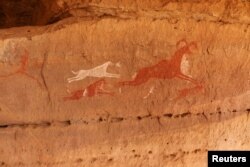TADRART ACACUS, LIBYA —
Vandals have destroyed prehistoric rock art in lawless southern Libya, endangering a sprawling tableau of paintings and carvings classified by UNESCO as of “outstanding universal value”.
Located along Libya's southwestern tip bordering Algeria, the Tadrart Acacus mountain massif is famous for thousands of cave paintings and carvings going back up to 14,000 years.
The art, painted or carved on rocks sandwiched by spectacular sand dunes, showcase the changing flora and fauna of the Sahara stretching over thousands of years.
Highlights include a huge elephant carved on a rock face as well as giraffes, cows and ostriches rendered in caves dating back to an era when the region was not inhospitable desert.
But in a visit to Libya's remote far south, Reuters found many paintings destroyed or damaged by graffiti sprayers or people carving in their initials.
Tourist officials in Ghat, the nearest large town, said the vandalism started around 2009 when a former Libyan employee of a foreign tour company sprayed over several paintings in anger after he had been fired.
But the destruction has accelerated since the 2011 civil war which ousted dictator Moammer Gadhafi and then plunged the sprawling North African country into widespread armed anarchy.
With tourist and archeologists staying away on safety grounds, hunters have taken over the Acacus massif, shooting much of the wildlife across the arid, rugged landscape.
Weapons are available anywhere these days in a country where the central government based in Tripoli on the northern Mediterranean coast exerts scant authority and the nascent armed forces are no match for armed tribesmen and militias.
“The destruction is not just affecting the paintings but also the natural reserve. Hunters are to blame,” said Ahmed Sarhan, a tourist ministry official in Ghat.
“It's even a problem in Algeria. Authorities are too weak to stop it,” he said, adding that wildlife such as gazelles and wolves had been almost extinguished by local hunters.
“It [Acacus] contains some of the most extraordinary scenery in the world and has its unique natural wonders,” UNESCO, the United Nations cultural agency, said on its website. UNESCO has listed Acacus as a World Heritage site, one of 981 worldwide recognized for their outstanding universal value to humanity.
“Many tourists [once] visited the area, in particular Acacus since it is one of the best touristic locations in Libya,” said al-Amin al-Ansari, a local tour operator. “The destruction of paintings is regrettable,” he said, standing in front of a cave with desecrated paintings of camels and other animals.
Located along Libya's southwestern tip bordering Algeria, the Tadrart Acacus mountain massif is famous for thousands of cave paintings and carvings going back up to 14,000 years.
The art, painted or carved on rocks sandwiched by spectacular sand dunes, showcase the changing flora and fauna of the Sahara stretching over thousands of years.
Highlights include a huge elephant carved on a rock face as well as giraffes, cows and ostriches rendered in caves dating back to an era when the region was not inhospitable desert.
But in a visit to Libya's remote far south, Reuters found many paintings destroyed or damaged by graffiti sprayers or people carving in their initials.
Tourist officials in Ghat, the nearest large town, said the vandalism started around 2009 when a former Libyan employee of a foreign tour company sprayed over several paintings in anger after he had been fired.
But the destruction has accelerated since the 2011 civil war which ousted dictator Moammer Gadhafi and then plunged the sprawling North African country into widespread armed anarchy.
With tourist and archeologists staying away on safety grounds, hunters have taken over the Acacus massif, shooting much of the wildlife across the arid, rugged landscape.
Weapons are available anywhere these days in a country where the central government based in Tripoli on the northern Mediterranean coast exerts scant authority and the nascent armed forces are no match for armed tribesmen and militias.
“The destruction is not just affecting the paintings but also the natural reserve. Hunters are to blame,” said Ahmed Sarhan, a tourist ministry official in Ghat.
“It's even a problem in Algeria. Authorities are too weak to stop it,” he said, adding that wildlife such as gazelles and wolves had been almost extinguished by local hunters.
“It [Acacus] contains some of the most extraordinary scenery in the world and has its unique natural wonders,” UNESCO, the United Nations cultural agency, said on its website. UNESCO has listed Acacus as a World Heritage site, one of 981 worldwide recognized for their outstanding universal value to humanity.
“Many tourists [once] visited the area, in particular Acacus since it is one of the best touristic locations in Libya,” said al-Amin al-Ansari, a local tour operator. “The destruction of paintings is regrettable,” he said, standing in front of a cave with desecrated paintings of camels and other animals.










